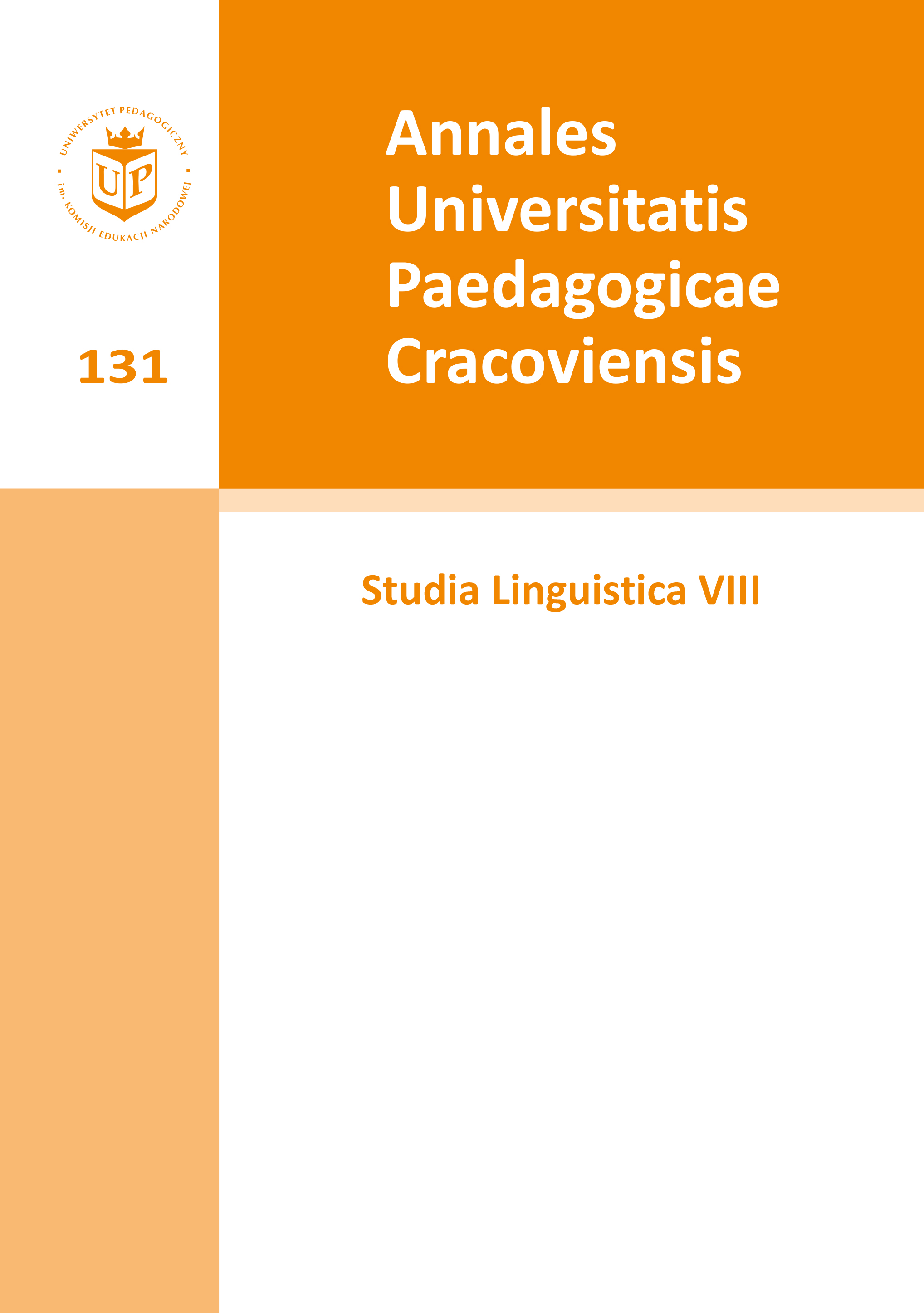Grubość i chudość w polszczyźnie
Main Article Content
Abstrakt
The article refers to the currently popular problem of “fighting with extra weight”. The paper presents various verbal and stylistic ways of naming thick and thin people used in today’s Polish language, especially in its colloquial (informal) form. The analysis is based on a collection of about 440 different terms used for describing thick and thin people as well as common words and phrases that form the word field of thickness and thinness. In addition to the basic synonyms and idioms which name these deficiencies in the physical appearance, the article shows, among others, names that connote the level of massiveness of the human body, verbs that refer to gaining and losing weight, words describing characteristic, visible features associated with obesity or leanness. It also distinguishes four groups of metaphorical expressions of corpulent and slim people, motivated by a variety of names designating respectively round or thin and narrow shape or appearance. The author also notes significant lexical-quantitative disproportion of vocabulary concerning thickness in relation to the vocabulary of the verbal field of thinness, suggesting that there is an asymmetry that could be the verbal evidence of “fighting with obesity.”
Downloads
Article Details
Autor, zgłaszając tekst do redakcji czasopisma „Annales Universitatis Paedagogicae Cracoviensis. Studia Linguistica”, zaświadcza, iż jest on rezultatem wyłącznie jego własnej twórczości, że treść artykułu nie była dotychczas publikowana oraz że utwór nie narusza w żadnym stopniu praw autorskich ani praw pokrewnych innych osób, jak również innych praw osób trzecich, a także, że niczyje prawa do utworu (lub jego jakiejkolwiek części) nie zostały pominięte. Po podpisaniu umowy prawa majątkowe do opublikowanych materiałów zostają przeniesione na Wydawnictwo Naukowe Uniwersytetu Komisji Edukacji Narodowej w Krakowie.
Rocznik „Annales Universitatis Paedagogicae Cracoviensis. Studia Linguistica” to czasopismo o otwartym dostępie, a cała jego zawartość jest udostępniana bezpłatnie dla użytkowników i instytucji na zasadach licencji Creative Commons CC-BY-NC-ND 4.0 (uznanie autorstwa, użycie niekomercyjne, bez utworów zależnych). Na podstawie tej licencji autorzy zgadzają się, że ich prace mogą być zgodnie z prawem ponownie wykorzystywane do jakichkolwiek celów, za wyjątkiem celów komercyjnych, bez konieczności uzyskania uprzedniej zgody ze strony autora lub wydawcy. Każdy może prace te czytać, pobierać, kopiować, drukować, rozpowszechniać oraz przetwarzać, pod warunkiem poprawnego oznaczenia autorstwa oraz oryginalnego miejsca publikacji. Publikowanych tekstów nie można wykorzystywać do tworzenia utworów zależnych (np. do tłumaczenia ich i publikowania w innym języku bez zgody wydawcy). Jest to zgodne z definicją otwartego dostępu BOAI (Budapest Open Access Initiative) „Studia Linguistica”nie pobiera opłat za składanie artykułów ani ich przetwarzanie.
Autor, przesyłając artykuł do redakcji „Studia Linguistica”, bezwględnie zgadza się z poniższymi punktami:
-
Oświadczam, że jestem Autorem lub Współautorem nadesłanego tekstu. Przesłany tekst nie był nigdzie publikowany, jest całkowicie oryginalny i nie narusza w żadnym stopniu praw autorskich ani praw pokrewnych innych osób, jak również innych praw osób trzecich, a także, że niczyje prawa do utworu nie zostały pominięte.
-
Oświadczam, że nadesłany tekst nie został złożony do recenzji lub/i publikacji w innym czasopiśmie.
-
Przyjmuję do wiadomości, że Autor ponosi pełną odpowiedzialność za każdy przypadek plagiatu, niezależnie od tego, czy został on wykryty podczas procesu recenzji, czy po publikacji w „Studia Linguistica”.
-
Oświadczam, że ponoszę pełną odpowiedzialność finansową i prawną za wszelkie roszczenia związane z utworem.
-
Potwierdzam uznanie wszystkich źródeł danych wykorzystanych i cytowanych w badaniach.
-
Potwierdzam, że artykuł został wykonany z należytą starannością zgodnie ze standardami edytorskimi „Studia Linguistica”.
Bibliografia
Dąbrowska A., 1992, Eufemizmy mowy potocznej, [w:] Potoczność w języku i kulturze, red. J. Anusiewicz, F. Nieckula, Wrocław, s. 119–178 (Język a Kultura, t. 5).
Google Scholar
Dąbrowska A., 1994, Eufemizmy współczesnego języka polskiego, Wrocław.
Google Scholar
Historia ciała, 2011, t. 1: Od renesansu do oświecenia, red. G. Vigarello, Gdańsk.
Google Scholar
Kłosiewicz-Lepianka M., 2004, Profile pojęcia ciało w dzisiejszej prasie kobiecej, „Poradnik Językowy”, z. 7, s. 30–44.
Google Scholar
Kopaliński W., 1996, Słownik eponimów, czyli wyrazów odimiennych, Warszawa.
Google Scholar
Krawczyk A., 1991, Ciało człowieka w świetle frazeologii gwarowej, [w:] Podstawowe pojęcia i problemy, red. J. Anusiewicz, J. Bartmiński, Wrocław, s. 143–147 (Język a Kultura, t. 1).
Google Scholar
Peisert M., 2003, Sus domesticus – zwierzę, którego nazwy używać nie wypada, [w:] Opozycja homo – animal w języku i kulturze, red. A. Dąbrowska, Wrocław, s. 149–155 (Język a Kultura, t. 15).
Google Scholar
Peisert M., 2004, Formy i funkcje agresji werbalnej. Próba typologii, Wrocław.
Google Scholar
Sękowska E., 1999, Językowy obraz ciała w prasie ostatnich lat, [w:] Polszczyzna w komunikowaniu publicznym, red. W. Gruszczyński, J. Bralczyk, G. Majkowska, Warszawa, s. 69–77.
Google Scholar
Zimnowoda J., 2003, Opozycja homo – animal w ekspresywnych zwrotach językowych, [w:] Opozycja homo – animal w języku i kulturze, red. A. Dąbrowska, Wrocław, s. 103–115 (Język a Kultura, t. 15).
Google Scholar
